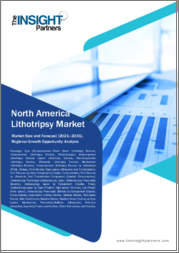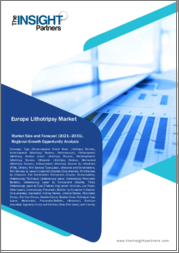
|
시장보고서
상품코드
1635998
쇄석기 시장 보고서 : 디바이스별, 용도별, 최종사용자별, 지역별(2025-2033년)Lithotripters Market Report by Device, Application, End User, and Region 2025-2033 |
||||||
쇄석기 시장의 세계 시장 규모는 2024년 17억 9,000만 달러에 달했습니다. 향후 IMARC Group은 이 시장이 2033년까지 25억 3,000만 달러에 달할 것으로 예상하며, 2025년부터 2033년까지 3.73%의 연평균 성장률(CAGR)을 기록할 것으로 예측했습니다. 요로결석증 유병률 증가, 노인 인구 증가, 최소침습수술(MIS)에 대한 소비자 선호도 증가는 시장을 이끄는 주요 요인 중 하나입니다.
쇄석기는 비침습적 의료기기로, 일련의 전자기 충격파를 수조에 통과시켜 결석을 분쇄하는 장치입니다. 금속 외피와 폴리에틸렌 카테터로 구성되어 있으며, 카테터에는 바구니가 들어 있고, 카테터 끝은 쇄석기 손잡이에 연결되어 있습니다. 딱딱한 결석을 환자의 소변으로 자연적으로 배출되는 정도의 미세한 입자로 분쇄하는 데 필요한 최대 에너지를 공급합니다. 외과 의사가 비뇨기계, 췌장, 담관에 존재하는 결석을 제거할 때 주변 연부조직에는 거의 영향을 미치지 않습니다. 또한, 쇄석기에는 투시법, 초음파법 및 이 두 가지를 결합한 타겟팅 시스템이 있습니다. 현재 전 세계 병원과 외래 수술 센터(ASC)에서 점점 더 많이 사용되고 있습니다.
쇄석기 시장 동향:
노인 인구의 증가와 요로결석증 유병률의 증가는 시장에 긍정적인 영향을 미치는 주요 요인 중 하나입니다. 건강에 해로운 식습관, 즉석섭취식품(RTE)에 대한 선호도 변화, 개인의 바쁜 라이프스타일로 인해 신장결석, 담낭결석, 간결석 사례가 증가하고 있습니다. 이 또한 시장에 밝은 전망을 가져다주고 있습니다. 또한, 결석 분쇄술이 기존의 외과적 결석 제거 방법보다 결석 제거술이 더 낫다는 인식이 확산되고 있는 것도 시장을 주도하고 있습니다. 이와는 별도로, 통증과 흉터 감소, 회복 기간 단축, 절개창 축소, 정확도 향상, 합병증 위험 감소를 목표로 하는 최소침습수술(MIS)에 대한 소비자 지향의 변화는 체외충격파쇄석술(ESWL)에 대한 수요를 자극하고 있습니다. 또한, 조기 진단 및 조기 치료의 이점을 알리기 위해 각국 정부가 부과하는 유리한 규제가 시장 성장을 강화하고 있습니다. 또한, 인프라를 개선하기 위해 헬스케어 산업에 대한 투자도 증가하고 있으며, 이는 시장 전망을 긍정적으로 만들고 있습니다. 이와 더불어, 전기 기계식 및 공압식 충격식 결석 제거술과 같은 새로운 첨단 기술의 출현은 시장 성장을 촉진하고 있습니다. 또한, 병원 및 수술 센터의 확장은 쇄석기에 대한 세계 수요를 주도하고 있습니다. 또한, 주요 시장 기업들은 제휴, 인수, 해외 고객과의 파트너십, 신제품 출시 등을 통해 시장 진입을 확대하기 위해 노력하고 있습니다.
본 보고서에서 다루는 주요 질문
- 세계 쇄석기 시장은 지금까지 어떻게 성장해 왔으며, 앞으로 어떻게 변화할 것인가?
- 세계 쇄석기 시장 세계 시장에서의 촉진요인, 저해요인, 기회요인은 무엇인가?
- 주요 지역 시장은?
- 가장 매력적인 쇄석기 시장은 어느 국가에서 가장 매력적일까?
- 기기별 시장 현황은?
- 용도별 시장 내역은?
- 최종사용자별 시장 분석은 어떻게 되는가?
- 세계 쇄석기 시장의 경쟁 구도는?
- 석재 파쇄기(리소트립터) 시장 세계 시장에서 주요 플레이어/기업은?
목차
제1장 서문
제2장 조사 범위와 조사 방법
- 조사 목적
- 이해관계자
- 데이터 소스
- 1차 정보
- 2차 정보
- 시장 추정
- 상향식 접근
- 하향식 접근
- 조사 방법
제3장 주요 요약
제4장 소개
- 개요
- 주요 업계 동향
제5장 세계의 쇄석기 시장
- 시장 개요
- 시장 실적
- COVID-19의 영향
- 시장 예측
제6장 시장 내역 : 디바이스별
- 체외 충격파 쇄석 시스템
- 시장 동향
- 시장 예측
- 체내 쇄석 시스템
- 시장 동향
- 주요 부문
- 레이저 쇄석술
- 전기수압 쇄석술
- 기계적 쇄석술
- 초음파 쇄석술
- 시장 예측
제7장 시장 내역 : 용도별
- 신장 결석
- 시장 동향
- 시장 예측
- 요관 결석
- 시장 동향
- 시장 예측
- 췌석
- 시장 동향
- 시장 예측
- 담관 결석
- 시장 동향
- 시장 예측
제8장 시장 내역 : 최종사용자별
- 병원
- 시장 동향
- 시장 예측
- 외래 수술 센터
- 시장 동향
- 시장 예측
- 기타
- 시장 동향
- 시장 예측
제9장 시장 내역 : 지역별
- 북미
- 미국
- 캐나다
- 아시아태평양
- 중국
- 일본
- 인도
- 한국
- 호주
- 인도네시아
- 기타
- 유럽
- 독일
- 프랑스
- 영국
- 이탈리아
- 스페인
- 러시아
- 기타
- 라틴아메리카
- 브라질
- 멕시코
- 기타
- 중동 및 아프리카
제10장 촉진요인, 억제요인, 기회
- 개요
- 성장 촉진요인
- 성장 억제요인
- 기회
제11장 밸류체인 분석
제12장 Porter's Five Forces 분석
- 개요
- 구매자의 교섭력
- 공급 기업의 교섭력
- 경쟁 정도
- 신규 참여업체의 위협
- 대체품의 위협
제13장 가격 분석
제14장 경쟁 구도
- 시장 구조
- 주요 기업
- 주요 기업 개요
- Boston Scientific Corporation
- Convergent Laser Technologies
- Cook Group Incorporated
- DirexGroup
- Dornier MedTech GmbH(Accuron Technologies Limited)
- EDAP TMS
- Medispec
- Olympus Corporation
- Storz Medical AG
The global lithotripters market size reached USD 1.79 Billion in 2024. Looking forward, IMARC Group expects the market to reach USD 2.53 Billion by 2033, exhibiting a growth rate (CAGR) of 3.73% during 2025-2033. The growing prevalence of urolithiasis, increasing geriatric population, and rising consumer preferences for minimally invasive surgeries (MIS) represent some of the key factors driving the market.
Lithotripters are non-invasive medical devices that pulverize stones by passing a series of electromagnetic shock waves through the water bath. They comprise a metal sheath covering and a polyethylene catheter, which contains the basket and the end of the catheter is connected to the lithotripter handle. They provide the maximum energy required to break the hard stone into fine particles that are enough to be passed naturally in the urine of the patient. They assist surgeons in removing stones present in the urinary system, pancreas, and bile ducts while leaving the surrounding soft tissue virtually unaffected. In addition, lithotripters have targeting systems that use fluoroscopy, ultrasonography, and a combination of both modalities. At present, they are increasingly being used in hospitals and ambulatory surgical centers (ASCs)across the globe.
Lithotripters Market Trends:
The rising geriatric population and the rising prevalence of urolithiasis represent one of the key factors positively influencing the market. The unhealthy dietary patterns, shifting preferences towards ready-to-eat (RTE) foods, and hectic lifestyles of individuals are resulting in the rising cases of kidney, gall bladder, and liver stones. This, in turn, is also creating a positive outlook for the market. In addition, the growing awareness among individuals about the benefits of lithotripsy over conventional surgical stone removal methods is driving the market. Apart from this, shifting consumer inclination towards minimally invasive surgeries (MIS) for lesser pain and scars, shorter recovery periods, smaller incisions, increased accuracy, and decreased risk of complications is catalyzing the demand for extracorporeal shock wave lithotripsy (ESWL) procedures. Furthermore, favorable regulations imposed by governments of various countries to educate people about the benefits of early diagnosis and treatment are strengthening the market growth. Additionally, they are increasingly investing in the healthcare industry to improve the infrastructure, which is offering a favorable market outlook. Besides this, the advent of new and advanced technologies, such as electromechanical and pneumatic impact lithotripsy, is propelling the market growth. Moreover, the expansion of hospitals and surgical centers is driving the global demand for lithotripters. Furthermore, leading market players are engaging in alliances, acquisitions, partnerships with international clients, and new product launches to expand their market reach.
Key Market Segmentation:
Device Insights:
- Extracorporeal Shock Wave Lithotripsy System
- Intracorporeal Lithotripsy System
- Laser Lithotripsy
- Electrohydraulic Lithotripsy
- Mechanical Lithotripsy
- Ultrasonic Lithotripsy
Application Insights:
- Kidney Stones
- Ureteral Stones
- Pancreatic Stones
- Bile Duct Stones
End User Insights:
- Hospitals
- Ambulatory Surgical Centers
- Others
Regional Insights:
- North America
- United States
- Canada
- Asia Pacific
- China
- Japan
- India
- South Korea
- Australia
- Indonesia
- Others
- Europe
- Germany
- France
- United Kingdom
- Italy
- Spain
- Russia
- Others
- Latin America
- Brazil
- Mexico
- Others
- Middle East and Africa
- The report has also provided a comprehensive analysis of all the major regional markets that include North America (The United States and Canada), Asia Pacific (China, Japan, India, South Korea, Australia, Indonesia, and others), Europe (Germany, France, the United Kingdom, Italy, Spain, Russia, and others), Latin America (Brazil, Mexico, and others), and the Middle East and Africa. According to the report, North America was the largest market for lithotripters. Some of the factors driving the North America lithotripters market included the high prevalence of kidney and ureteral stones, increasing number of surgeries performed each year, and technological advancements in the healthcare industry.
Competitive Landscape:
- The report has also provided a comprehensive analysis of the competitive landscape in the global lithotripters market. Detailed profiles of all major companies have also been provided. Some of the companies covered include Boston Scientific Corporation, Convergent Laser Technologies, Cook Group Incorporated, DirexGroup, Dornier MedTech GmbH (Accuron Technologies Limited), EDAP TMS, Medispec, Olympus Corporation, Storz Medical AG, etc. Kindly note that this only represents a partial list of companies, and the complete list has been provided in the report.
Key Questions Answered in This Report:
- How has the global lithotripters market performed so far and how will it perform in the coming years?
- What are the drivers, restraints, and opportunities in the global lithotripters market?
- What are the key regional markets?
- Which countries represent the most attractive lithotripters markets?
- What is the breakup of the market based on the device?
- What is the breakup of the market based on the application?
- What is the breakup of the market based on the end user?
- What is the competitive structure of the global lithotripters market?
- Who are the key players/companies in the global lithotripters market?
Table of Contents
1 Preface
2 Scope and Methodology
- 2.1 Objectives of the Study
- 2.2 Stakeholders
- 2.3 Data Sources
- 2.3.1 Primary Sources
- 2.3.2 Secondary Sources
- 2.4 Market Estimation
- 2.4.1 Bottom-Up Approach
- 2.4.2 Top-Down Approach
- 2.5 Forecasting Methodology
3 Executive Summary
4 Introduction
- 4.1 Overview
- 4.2 Key Industry Trends
5 Global Lithotripters Market
- 5.1 Market Overview
- 5.2 Market Performance
- 5.3 Impact of COVID-19
- 5.4 Market Forecast
6 Market Breakup by Device
- 6.1 Extracorporeal Shock Wave Lithotripsy System
- 6.1.1 Market Trends
- 6.1.2 Market Forecast
- 6.2 Intracorporeal Lithotripsy System
- 6.2.1 Market Trends
- 6.2.2 Key Segments
- 6.2.2.1 Laser Lithotripsy
- 6.2.2.2 Electrohydraulic Lithotripsy
- 6.2.2.3 Mechanical Lithotripsy
- 6.2.2.4 Ultrasonic Lithotripsy
- 6.2.3 Market Forecast
7 Market Breakup by Application
- 7.1 Kidney Stones
- 7.1.1 Market Trends
- 7.1.2 Market Forecast
- 7.2 Ureteral Stones
- 7.2.1 Market Trends
- 7.2.2 Market Forecast
- 7.3 Pancreatic Stones
- 7.3.1 Market Trends
- 7.3.2 Market Forecast
- 7.4 Bile Duct Stones
- 7.4.1 Market Trends
- 7.4.2 Market Forecast
8 Market Breakup by End User
- 8.1 Hospitals
- 8.1.1 Market Trends
- 8.1.2 Market Forecast
- 8.2 Ambulatory Surgical Centers
- 8.2.1 Market Trends
- 8.2.2 Market Forecast
- 8.3 Others
- 8.3.1 Market Trends
- 8.3.2 Market Forecast
9 Market Breakup by Region
- 9.1 North America
- 9.1.1 United States
- 9.1.1.1 Market Trends
- 9.1.1.2 Market Forecast
- 9.1.2 Canada
- 9.1.2.1 Market Trends
- 9.1.2.2 Market Forecast
- 9.1.1 United States
- 9.2 Asia-Pacific
- 9.2.1 China
- 9.2.1.1 Market Trends
- 9.2.1.2 Market Forecast
- 9.2.2 Japan
- 9.2.2.1 Market Trends
- 9.2.2.2 Market Forecast
- 9.2.3 India
- 9.2.3.1 Market Trends
- 9.2.3.2 Market Forecast
- 9.2.4 South Korea
- 9.2.4.1 Market Trends
- 9.2.4.2 Market Forecast
- 9.2.5 Australia
- 9.2.5.1 Market Trends
- 9.2.5.2 Market Forecast
- 9.2.6 Indonesia
- 9.2.6.1 Market Trends
- 9.2.6.2 Market Forecast
- 9.2.7 Others
- 9.2.7.1 Market Trends
- 9.2.7.2 Market Forecast
- 9.2.1 China
- 9.3 Europe
- 9.3.1 Germany
- 9.3.1.1 Market Trends
- 9.3.1.2 Market Forecast
- 9.3.2 France
- 9.3.2.1 Market Trends
- 9.3.2.2 Market Forecast
- 9.3.3 United Kingdom
- 9.3.3.1 Market Trends
- 9.3.3.2 Market Forecast
- 9.3.4 Italy
- 9.3.4.1 Market Trends
- 9.3.4.2 Market Forecast
- 9.3.5 Spain
- 9.3.5.1 Market Trends
- 9.3.5.2 Market Forecast
- 9.3.6 Russia
- 9.3.6.1 Market Trends
- 9.3.6.2 Market Forecast
- 9.3.7 Others
- 9.3.7.1 Market Trends
- 9.3.7.2 Market Forecast
- 9.3.1 Germany
- 9.4 Latin America
- 9.4.1 Brazil
- 9.4.1.1 Market Trends
- 9.4.1.2 Market Forecast
- 9.4.2 Mexico
- 9.4.2.1 Market Trends
- 9.4.2.2 Market Forecast
- 9.4.3 Others
- 9.4.3.1 Market Trends
- 9.4.3.2 Market Forecast
- 9.4.1 Brazil
- 9.5 Middle East and Africa
- 9.5.1 Market Trends
- 9.5.2 Market Breakup by Country
- 9.5.3 Market Forecast
10 Drivers, Restraints, and Opportunities
- 10.1 Overview
- 10.2 Drivers
- 10.3 Restraints
- 10.4 Opportunities
11 Value Chain Analysis
12 Porters Five Forces Analysis
- 12.1 Overview
- 12.2 Bargaining Power of Buyers
- 12.3 Bargaining Power of Suppliers
- 12.4 Degree of Competition
- 12.5 Threat of New Entrants
- 12.6 Threat of Substitutes
13 Price Analysis
14 Competitive Landscape
- 14.1 Market Structure
- 14.2 Key Players
- 14.3 Profiles of Key Players
- 14.3.1 Boston Scientific Corporation
- 14.3.1.1 Company Overview
- 14.3.1.2 Product Portfolio
- 14.3.1.3 Financials
- 14.3.1.4 SWOT Analysis
- 14.3.2 Convergent Laser Technologies
- 14.3.2.1 Company Overview
- 14.3.2.2 Product Portfolio
- 14.3.3 Cook Group Incorporated
- 14.3.3.1 Company Overview
- 14.3.3.2 Product Portfolio
- 14.3.4 DirexGroup
- 14.3.4.1 Company Overview
- 14.3.4.2 Product Portfolio
- 14.3.5 Dornier MedTech GmbH (Accuron Technologies Limited)
- 14.3.5.1 Company Overview
- 14.3.5.2 Product Portfolio
- 14.3.6 EDAP TMS
- 14.3.6.1 Company Overview
- 14.3.6.2 Product Portfolio
- 14.3.6.3 Financials
- 14.3.7 Medispec
- 14.3.7.1 Company Overview
- 14.3.7.2 Product Portfolio
- 14.3.8 Olympus Corporation
- 14.3.8.1 Company Overview
- 14.3.8.2 Product Portfolio
- 14.3.8.3 Financials
- 14.3.8.4 SWOT Analysis
- 14.3.9 Storz Medical AG
- 14.3.9.1 Company Overview
- 14.3.9.2 Product Portfolio
- 14.3.9.3 SWOT Analysis
- 14.3.1 Boston Scientific Corporation
Kindly, note that this only represents a partial list of companies, and the complete list has been provided in the report.



















